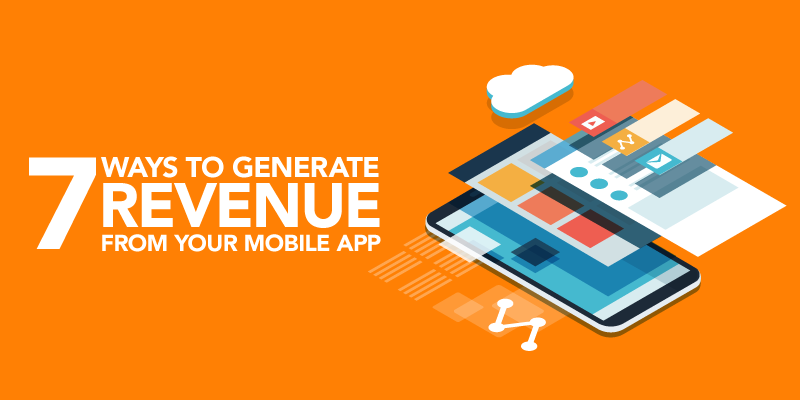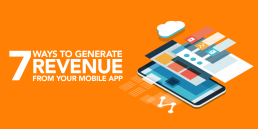7 Ways to Generate Revenue from Your Mobile App
So you’ve built a fantastic mobile app! Now, what’s your next step? How do you plan on generating revenue and achieving a return on investment from it? Bottom line, if your app isn’t paying for itself, you’re just bleeding resources, no matter how great the app’s functionality might be.

The mobile app development market shows no signs of slowing down. The app marketplace is growing more saturated with new apps each day (about 6,140 mobile apps are launched through the Google Play Store per day). Because of the high level of competition, you’ll need a lot of patience, knowledge, and creativity to build a monetization model that will bring revenue in.
When it comes to making the most out of app monetization, you need to market it before, during, and after its launch. You can’t just release and it and wait for money to pour in. If you want your users to spend money on your app, you’ll have to optimize it for profitable conversions.
Setting Goals & Measuring ROI
You’ll miss out a lot of opportunities and lag behind your competitors if you fail to implement concrete goals for your mobile app. If you aim to bring your mobile marketing efforts to the next level, you’ll want to design and implement objectives and strategies that boost engagement, drive awareness, and increase ROI. Here are five essential steps for setting goals and measuring your ROI:
- Create your mobile app measurement plan – Understand the primary function of your mobile app. Maybe it’s supposed to build awareness, generate leads, convert sales, or provide a subscription service.
- Create actionable metrics – You should identify the exact metrics that correlate to your specific goal and design tactics to positively influence those metrics. Actively measure and monitor primary metrics to quickly respond to potential market changes.
- Analyze Customer Lifetime Value – The customer lifetime value (CLV) indicates your expected revenue from each user throughout his or her engagement with the app.
- Determine your cost – Quantify your overall costs that go into maintaining, building, updating, and promoting the app.
- Know that not all users are the same – Different users create different consumptions patterns. Segment your acquisition channels using accurate buyer personas to reach more reliable ROI numbers.
In this infographic, you’ll see the various ways you can monetize your mobile app effectively.

Mobile App Monetization Strategies
Advertising
Well-executed in-app ads are one of the most effective mobile monetization methods. This works by connecting your mobile app with advertisers or through an ad platform and having them pay you to host highly-targeted ads. This can generate significant amounts of revenue if you already have a large app following.
This works best when:
- You don’t plan to profit directly from users
- You gather behavioral and demographic data
- Your app already has a large number of active users
Lead Generation
You can use your mobile app to pique the interest of potential clients to advertise or sell leads generated to other interested parties. This is particularly effective for finance companies. In a nutshell, they gather the financial data and sell it to credit card institutions and other concerned parties.
This works best when:
- Your app collects and analyzes valuable data
- Your app offers affiliate programs
Freemium App Model
The Freemium monetization model offers free, basic, and premium versions of your app. Brands find this strategy a great way to create a user base and accumulate those who are ready to pay for propriety features. This works effectively as long as the free app version still engages and retains the interest of your targeted audience.
You have to be clear about the limited number of features for those who prefer not to pay for the premium version. This is particularly common for a lot of Software as a Service (SaaS) based products.
This works best when:
- Your app’s premium features add significant value to consumers
- Your free version is appealing enough to compel users to pay for extra features
- You want to generate revenue directly from users and ads
In-app Purchases
This method essentially uses your app as another sales channel. But it’s important to note that despite these offerings, your app should remain functional without the digital upgrades. The add-ons should only serve as a way to improve the user experience. In-app purchases can refer to in-app consumables, ad removal, add-on features, and virtual currency.
This works best when:
- The in-app offerings provide real value to users
- The additional purchases will enhance the user experience
- Your basic app can stand without the extra fee, but the UX is impressive enough to encourage users to buy add-ons
App/SMS/Email Marketing
People rarely change their email addresses, which makes email newsletters a wise strategy in encouraging your users to see your content and interact with it. The same method applies in SMS marketing, people open every SMS text message they get and the same goes for in-app messages.
You can tap on potential leads or convert users from desktop to mobile onboarding by sending out a newsletter or an SMS promotions campaign.
This works when:
- Your campaigns are delivered and targeted to the right audience at the right time
- You aim to enhance customer engagement
- You seek to reach former/inactive users and compel them to re-engage
Subscription Services
Like the freemium model, the subscription method limits the features users can access within the app. Some apps offer the full use of the premium features or a predetermined amount of content for free within a limited time. Once the time is up, they ask the user to subscribe to continue using the app or access more content.
The primary challenge with this method is the responsibility of keeping content rolling in. If this is lacking, customer engagement will decrease, and subscribers may stop their subscriptions or not subscribe at all.
This works best when:
- You have a large and robust app audience
- You regularly deliver fresh and engaging content (videos, news, etc.)
- The nature of your app promotes recurrent use
Paid Apps
If people want to access your app, they need to purchase it from the app store. Paid apps can range from $0.99 to $999.99. This allows brands to earn money upfront with every new user. The key to succeeding in this monetizing model is to market your app’s unique features, from functionality to user experience.
This works best when:
- You have a valuable app that has stellar reviews and ratings
- Your app boasts superior features and functionality with no (or minimal) competition
- Your app is generally innovative in design, experience, and purpose
Mobile Monetization Trends
Video Ads
Mobile video ads remain to be an excellent way to monetize mobile apps, and the trend will only grow strong over the years. This isn’t a surprise since the ad format entices both users and marketers. It is predicted by eMarketer that U.S. mobile video ad spend will grow by up to 22.6% this year.
Paywalls
Paywalls or subscription services will continue to be a trend in the mobile app industry. It enables users to test drive the app before subscribing to get full access of the content. Apps that are able to tailor their premium model right will see a significant increase in monetization. If you incorporate auto-renewals, you can expect to get a steady and regular stream of revenue.
App experience
In this digital age, businesses are focusing on making apps that offers a smooth user experience rather than on pure profit. Research finds that improving the app experience is more important than monetization, which makes complete sense. If your app can keep users active and engaged, this will have a positive effect on user experience and driving a profit becomes easier.
The Future of Mobile App Monetization
App monetization techniques can be complex. Launching an app with no evident scalability could be a waste of investment. Contrary to popular belief, building apps can be a pretty expensive endeavor.
The mobile app market will continue to get more saturated in the coming months and years as brands continue to build and innovate with mobile app development. Businesses that want to be competitive need to build a comprehensive plan to scope out the right numbers using the right approach to measure and generate a solid ROI.
Thinking about building a mobile app for your business? Contact the experts at Intelligent Bee today!
